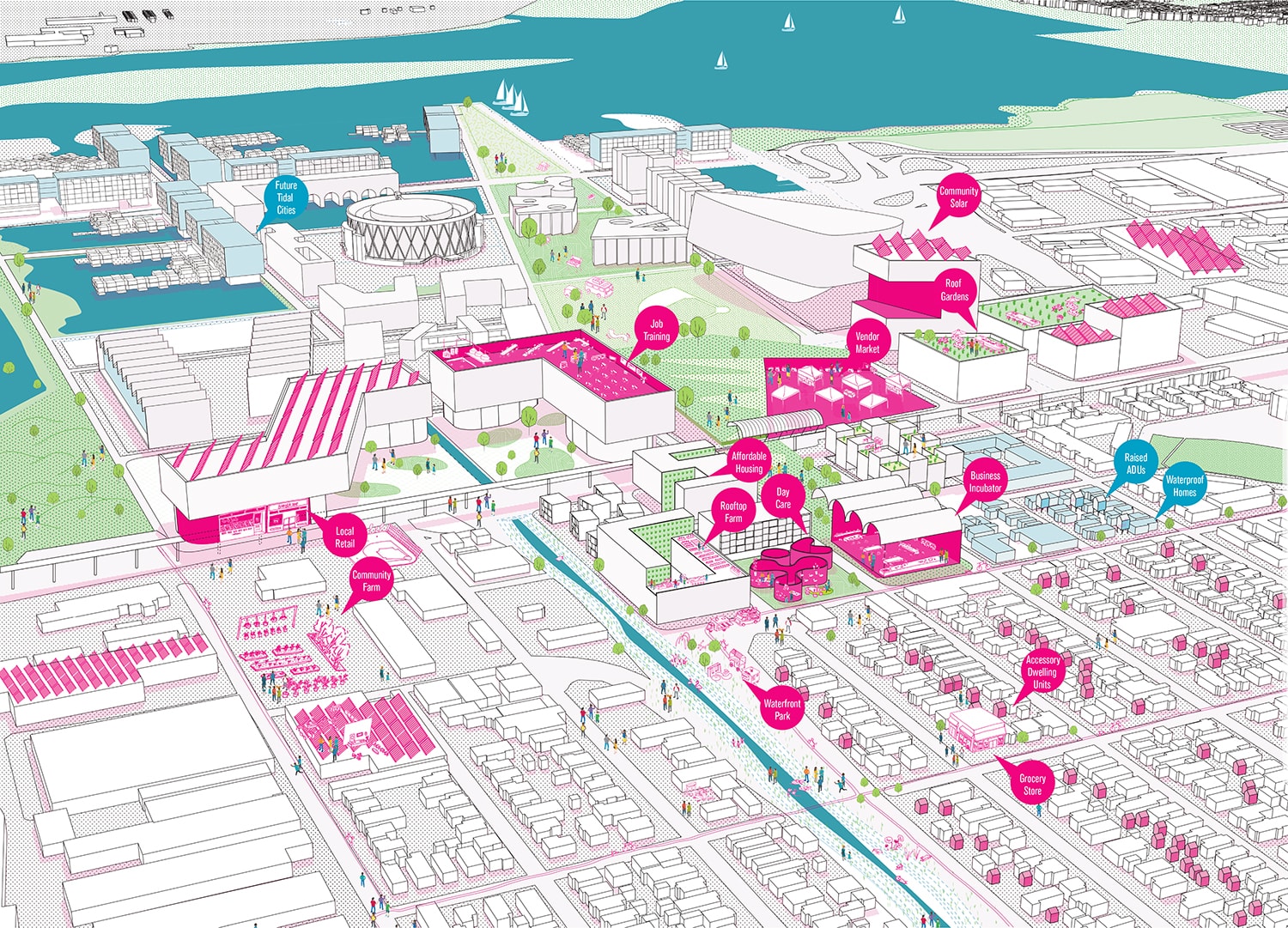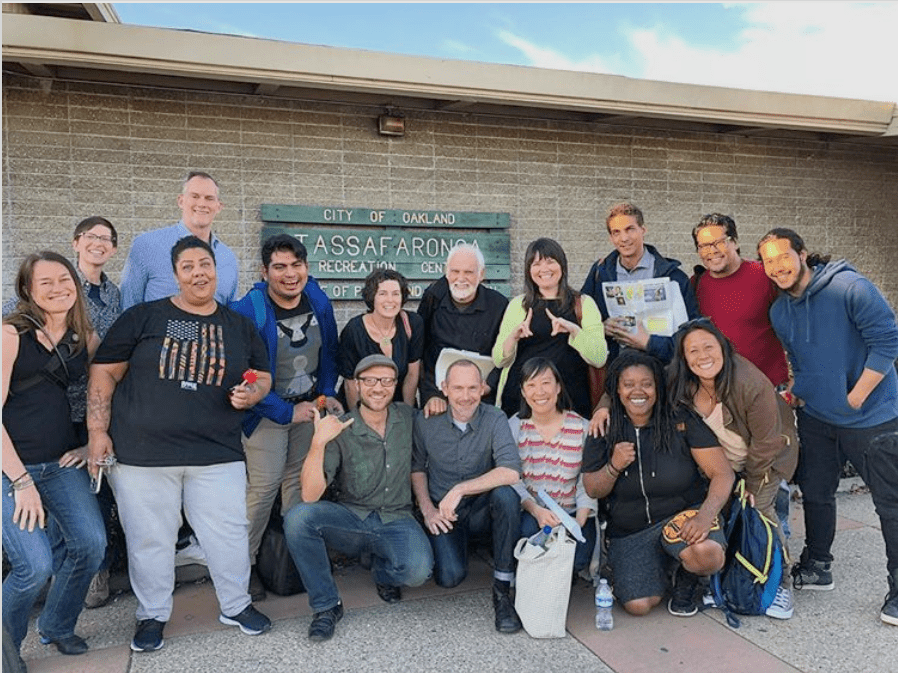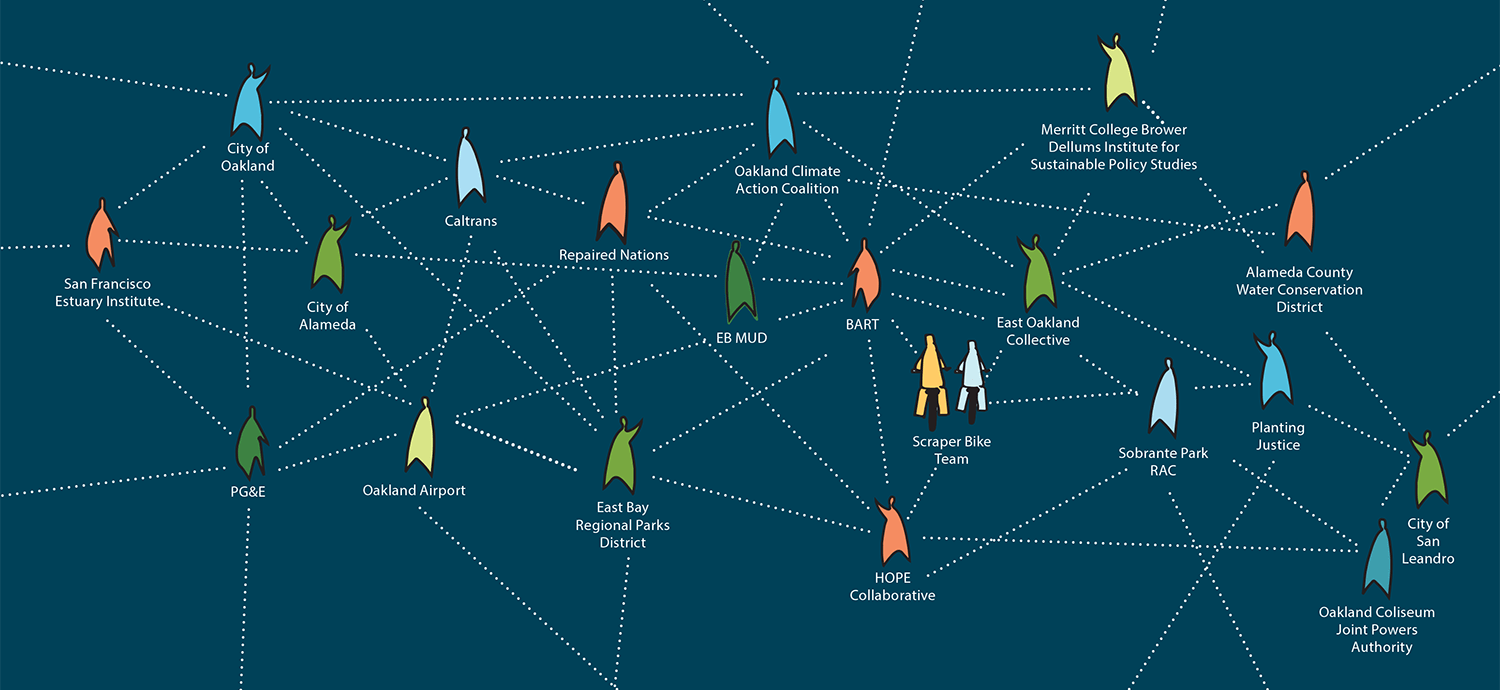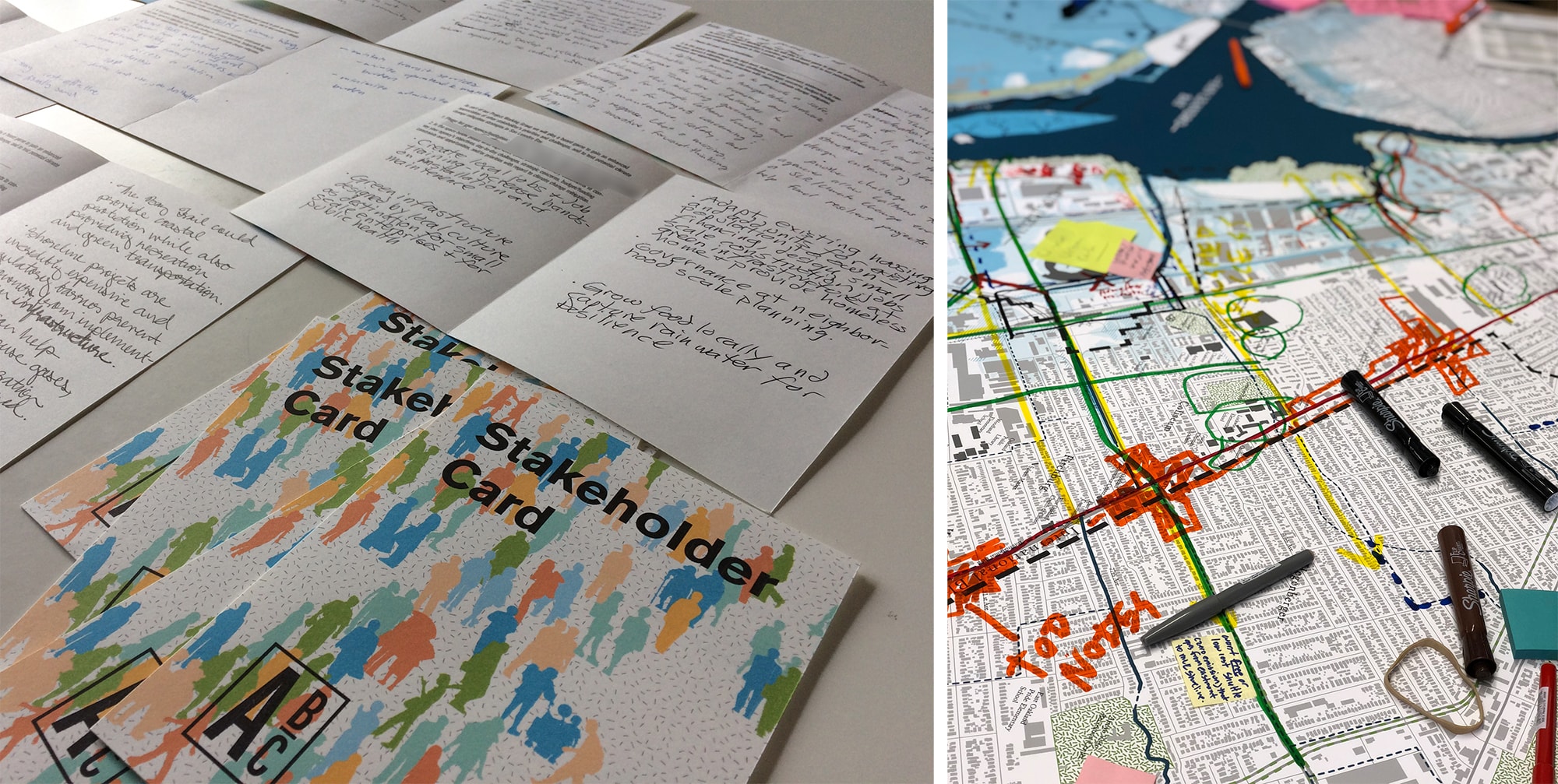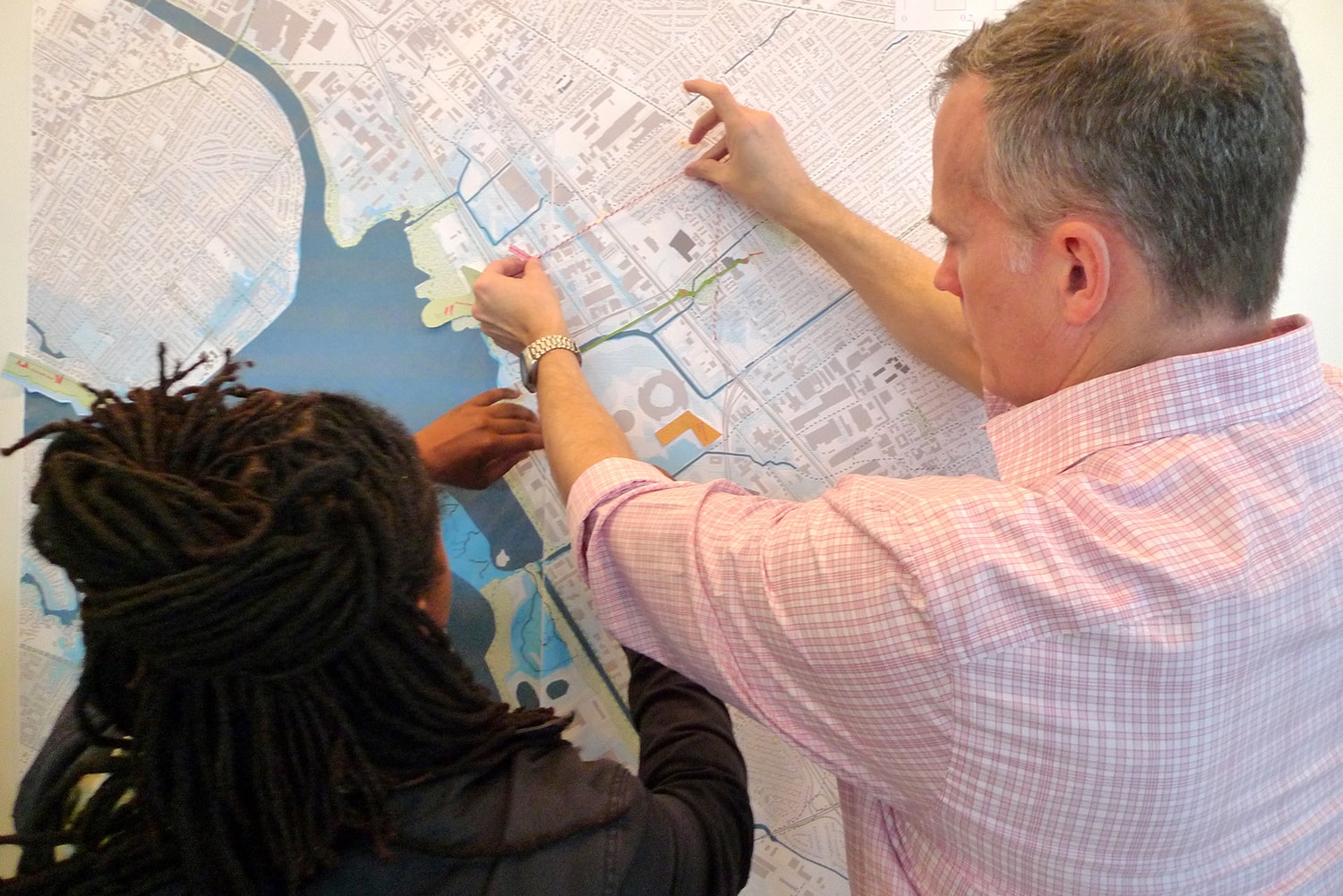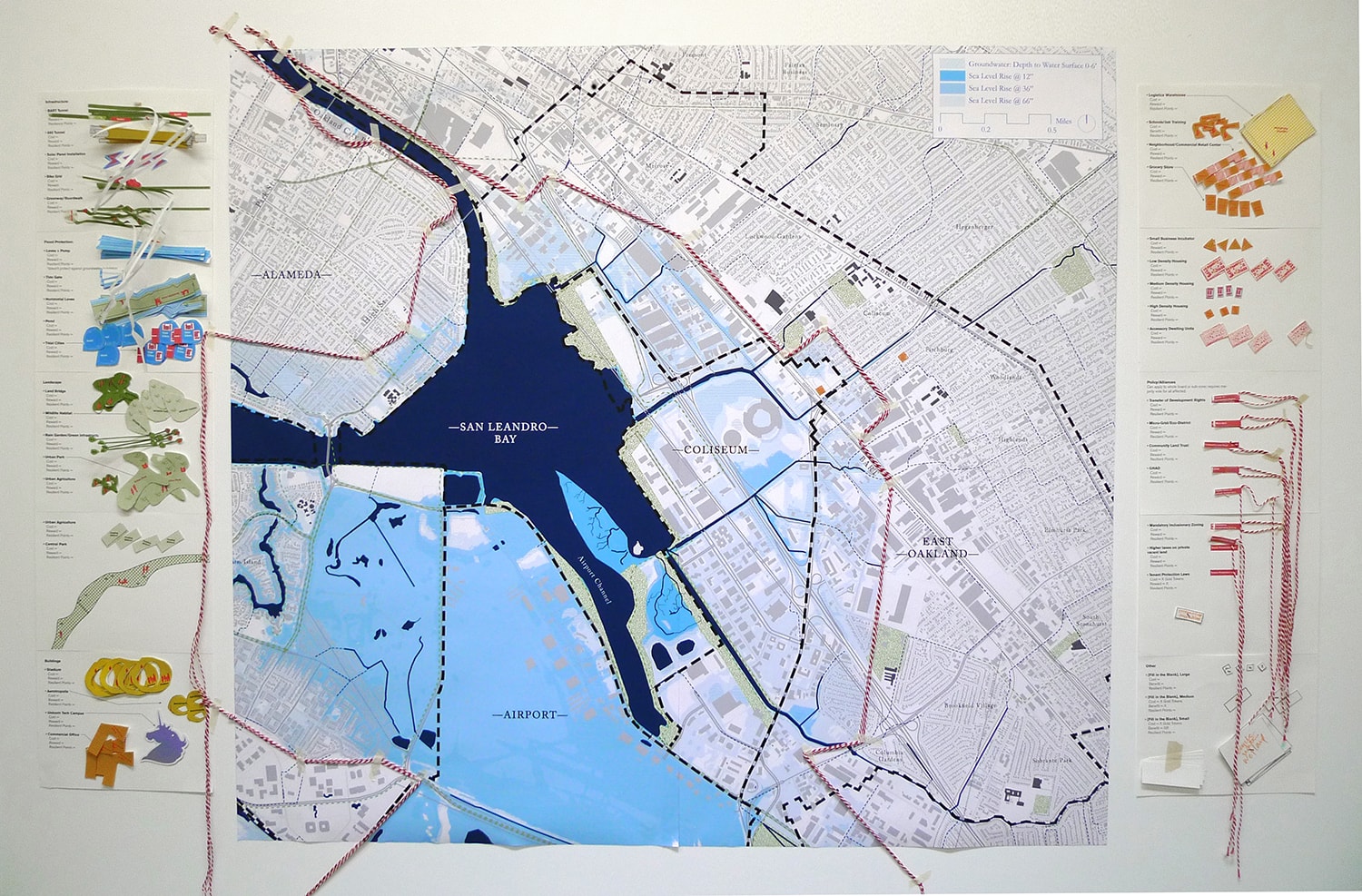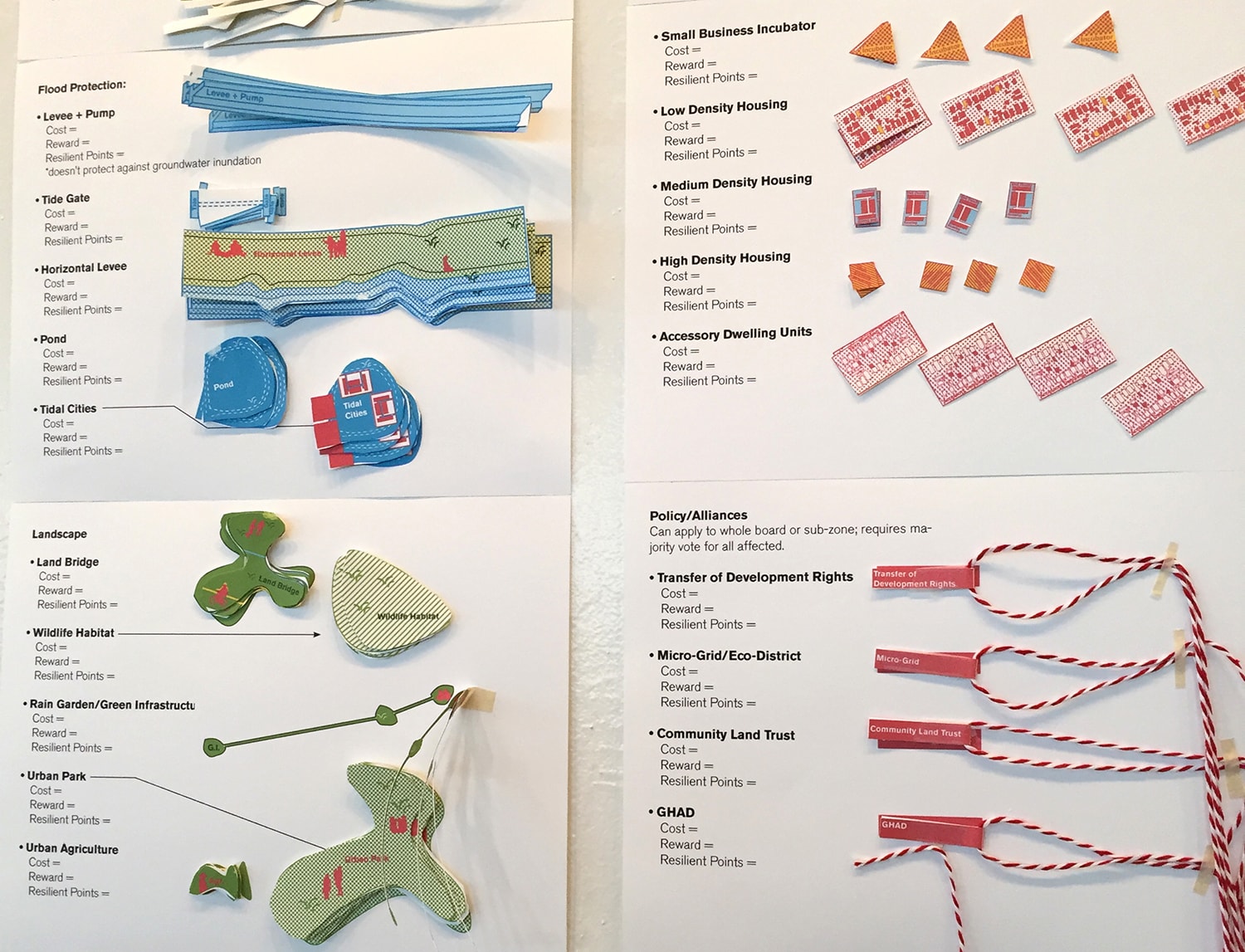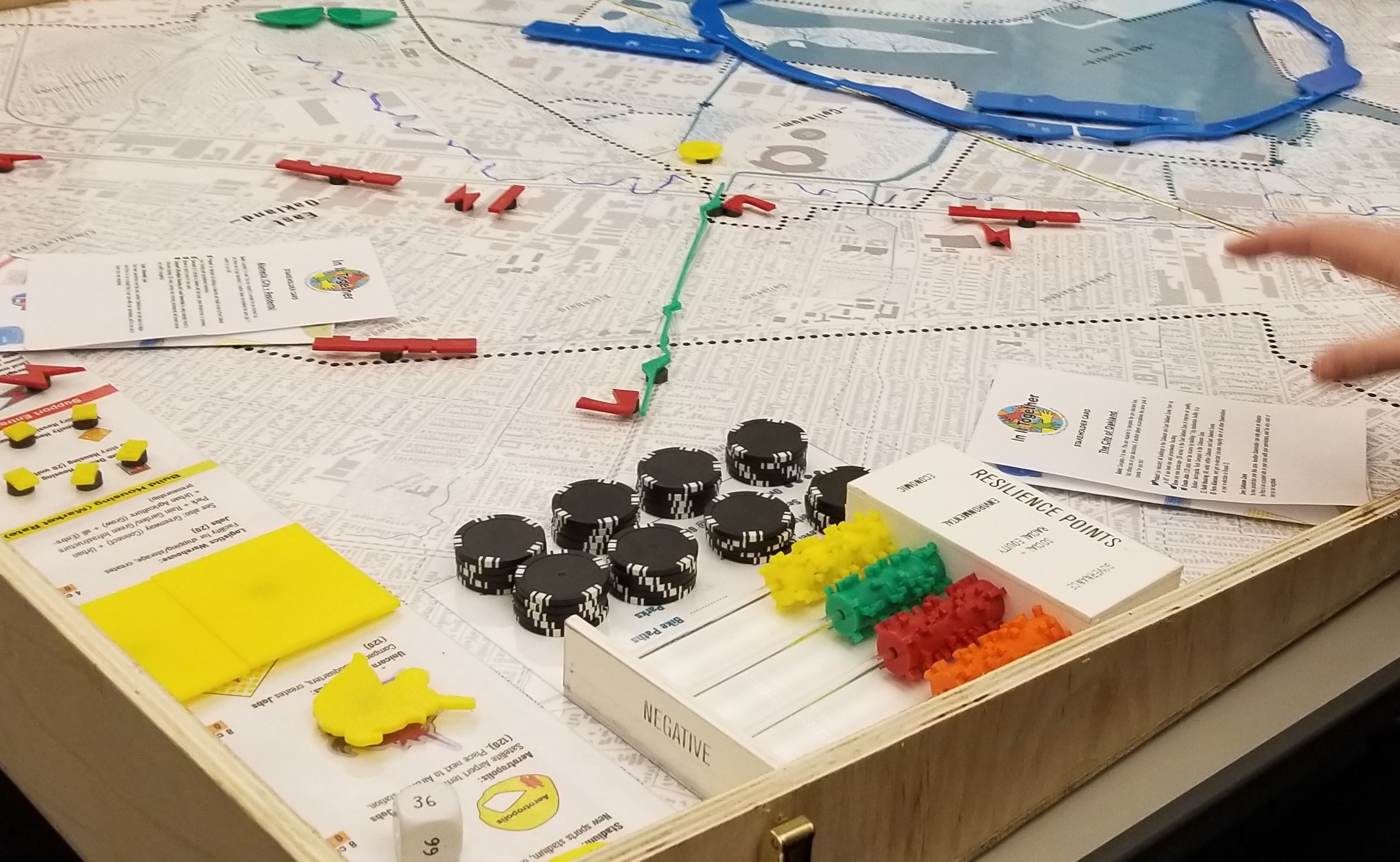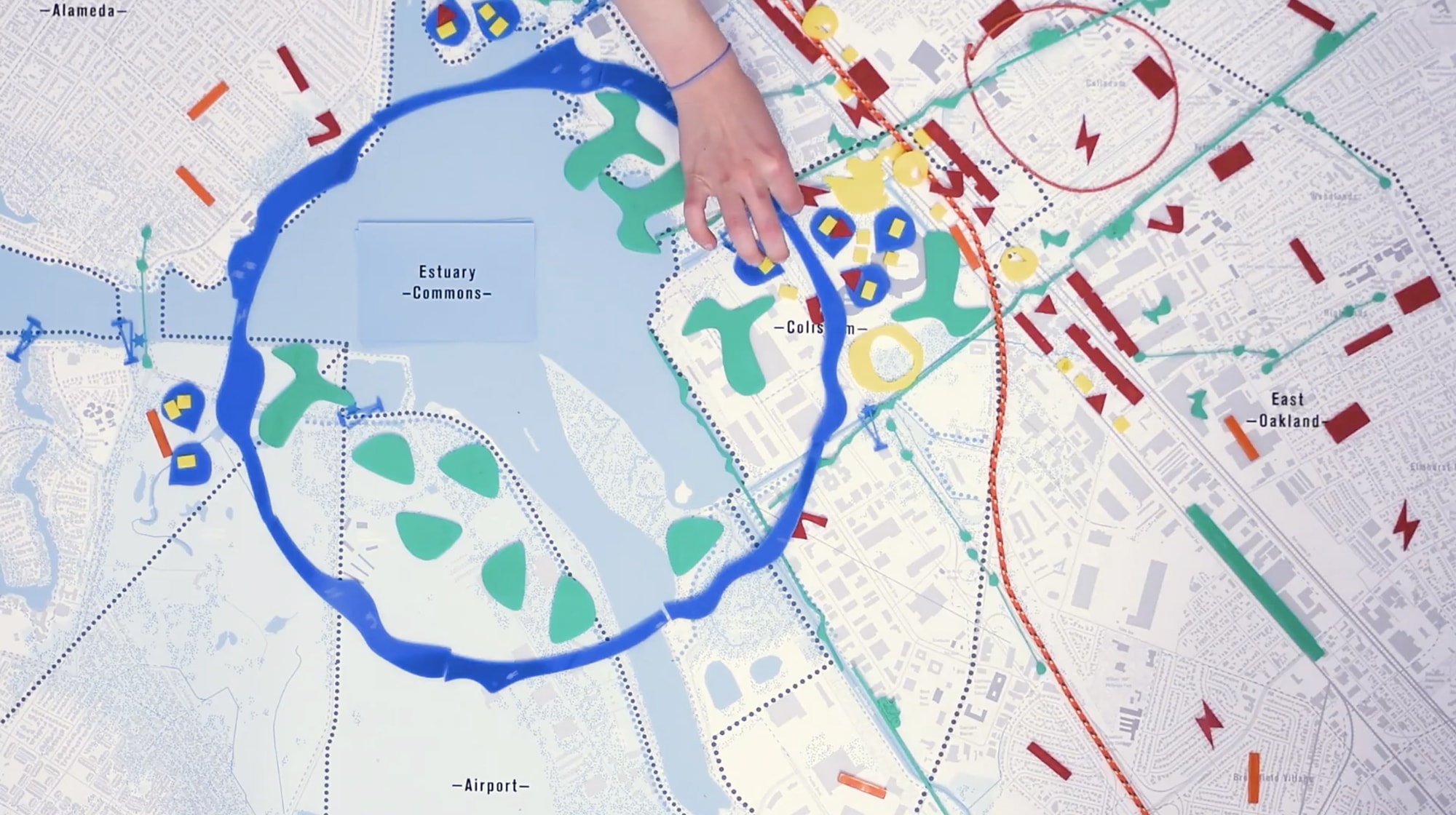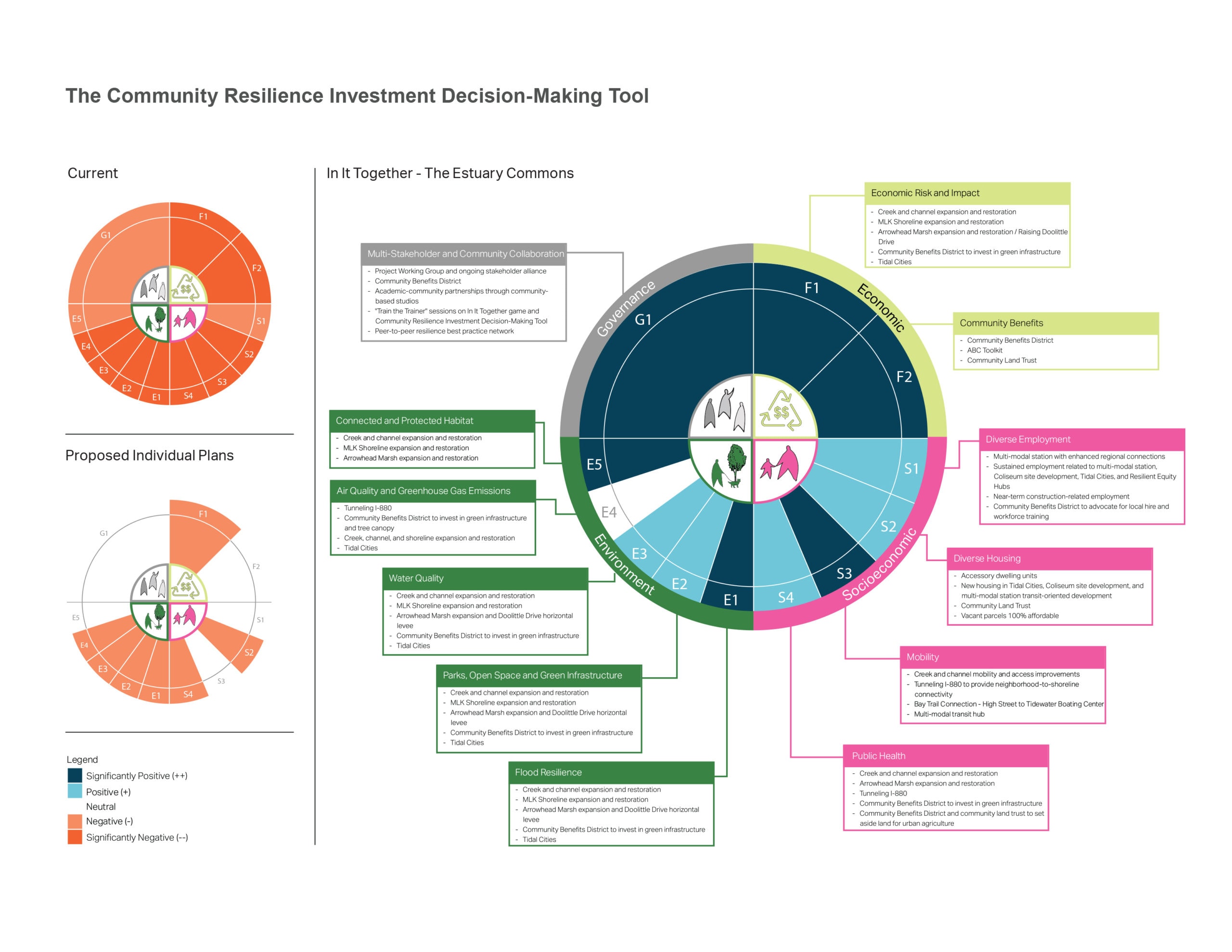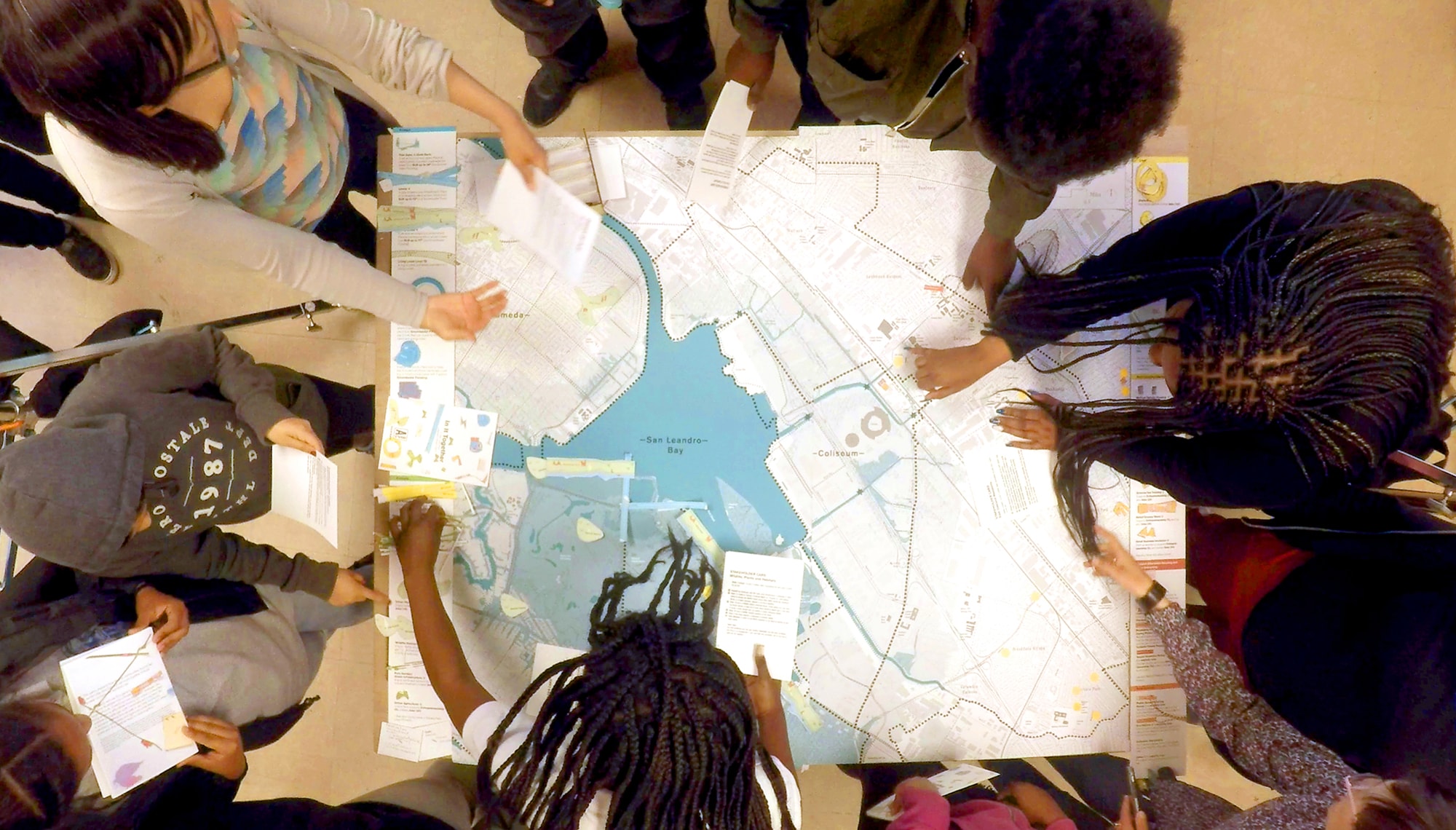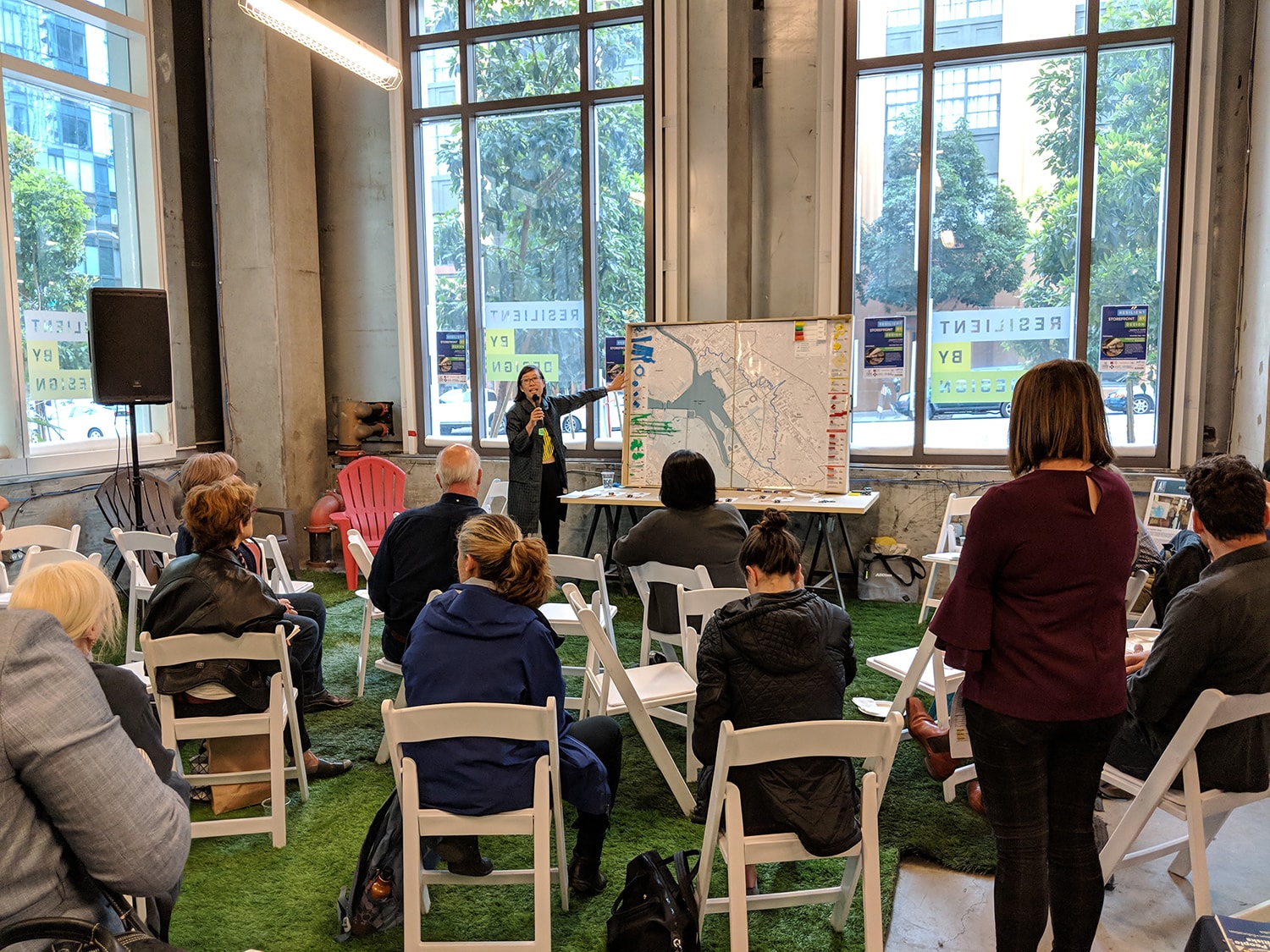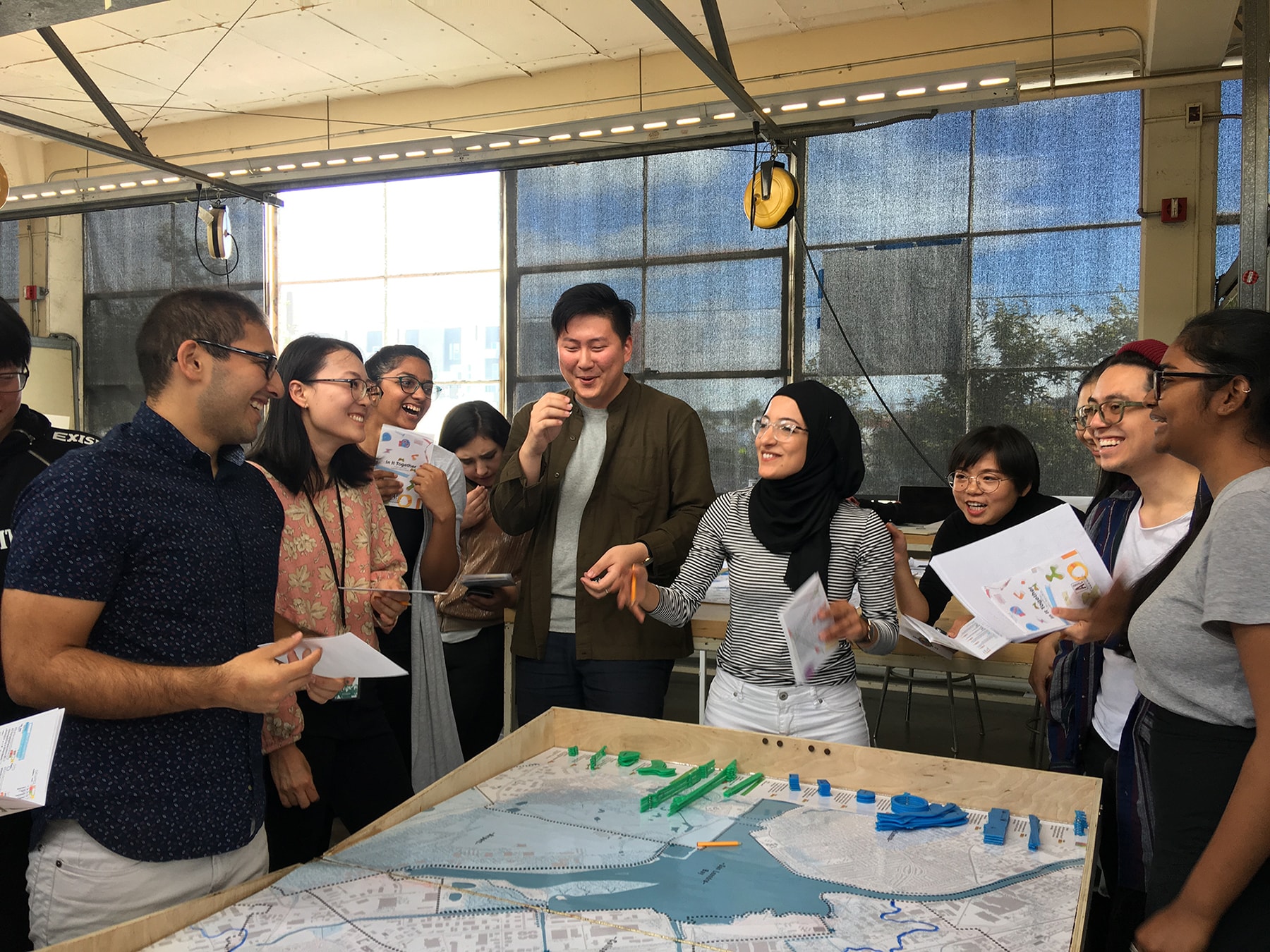A common rallying cry of the resilience movement is that change can be a win-win. Sometimes, it’s even a win-win-win. For a society to be capable of withstanding the catastrophic reach of climate change, the thinking goes, it must be retooled to absorb shocks and still keep operating. Achieving such elasticity would require big moves—reprogramming economic incentives, rewriting policy directives, investing in redundant infrastructures, and fostering diverse landscapes. The ability to absorb risk and not just deflect it promises to turn a threat into its own solution—that is, a win.
For resilience proponents, rhetoric pulled from game theory serves as a tool for coalition building. It draws in skeptics with a language that echoes both the logic of economic growth inextricable from the term sustainability, and the compulsion common in neoliberal governance to quantify values like equity and environment as profits. The term win-win suggests there are no tradeoffs. Indeed, the promise of no-guilt multi-benefit solutions has succeeded in forging significant alliances across seemingly disconnected resources like energy or water and diverse interests like homeownership or migrancy [1]. And yet, the very risks these solutions hope to defuse were themselves the product of tradeoffs—what is climate change but a byproduct of the combustion engine as well as the policies and industries that leverage it?
The term win-win aspires to generate power for wholesale change using the language of business as usual. It reaches out from one interest group to another without translating its own jargon. In turn, its usage gives testimony for critiques long lobbied against resilience—namely, that it requires the most vulnerable to absorb risk without challenging the disinvestment and exclusion that made them insecure in the first place [2]. The true power of resilience lies in its capacity to mobilize public spending, to affix risks in the public imagination, and to recognize that their reach extends across traditional disciplinary, ideological, and cultural boundaries. Still, meaningfully translating across camps and tapping the roots of structural inequities would require a more probing process of deliberation. Making more difficult decisions possible would require acknowledging that there are inevitably, deliberately, and regrettably losers—and have always been losers. Failure to daylight critical, and possibly generative, conflicts would sequester decision-making in smoke-filled rooms or, worse, leave these debates forgotten.
This article unpacks a series of board games I’ve created and produced over the past five years that expose the political contestations embroiled in climate risk. I’ve somewhat ironically titled the series Win-Win to acknowledge the “win-lose” and “lose-lose” end games also implied in climate-related futures thinking [3]. These games model relationships between sea level rise and social justice issues such as gentrification and displacement. They’re tools for engagement that prompt debate, acknowledge differences, and navigate their negotiation. Many of them were created in collaboration with government agencies and interdisciplinary partners for use in prompting discussion with constituents and provoking a more informed decision-making process. My aim is to demonstrate how games can unearth new sites of power and a recharged vision of inclusivity in the face of crisis.
In It Together
The Estuary Commons proposal by the All Bay Collective. This proposed network of tidal ponds, landforms, and expanded streams would enable cities surrounding the San Leandro Bay to adapt to sea level rise and groundwater flooding. Image by The All Bay Collective.
Resilient Equity Hubs (ReHBs) can ensure adaptation without displacement by supporting collective ownership of homes, businesses and natural resources. At a policy scale, value capture policies can leverage benefits from future infrastructural investments to collective and local initiatives. Image by The All Bay Collective.
The game In It Together was created for the Resilient by Design Bay Area Challenge (RBD), which was organized in 2017-18 by city and state agencies across the San Francisco Bay area and inspired by the Rebuild by Design challenge in New York and New Jersey after superstorm Sandy. Funded by the Rockefeller Foundation, RBD organizers selected 10 international teams to create design proposals that make the Bay Area more resilient to sea level rise and other climate-related risks. Our team was called the All Bay Collective, which combined expertise across architecture, landscape architecture, engineering, urban economics, housing policy, public advocacy, biology, film-making, and graphic design, among others [4]. We focused on combined groundwater and social justice challenges in San Leandro Bay, which connects Deep East Oakland with Alameda Island and the Oakland Airport. Our proposal, called “The Estuary Commons,” [5] developed strategies to share resources and space across landscapes, and among agencies and property owners.
The All Bay Collective with community-based partners in Deep East Oakland. Image by The All Bay Collective.
Project Working Group organization chart for The Estuary Commons. Image by The All Bay Collective.
We also worked closely with community-based organizations including the East Oakland Collective, Oakland Climate Action Coalition, Merritt College, and many others; as well as city and state agencies including the City of Oakland, East Bay Regional Parks District, and BART. The tight schedule of RBD left little time for fully developed collaboration with community partners already understandably reluctant to work with teams they did not themselves select. Still, our team was able to form trusting relationships by demonstrating that we weren’t interested in creating a single master plan—instead, our approach was to offer tools such as this game that neighborhood advocates could use.
Stakeholder cards completed by Project Working Group members from the design teams, community-based organizations and government agencies. Image: Janette Kim/Urban Works Agency with the All Bay Collective [left]. Project Working Group sketch. Image: Janette Kim/Urban Works Agency. Image by The All Bay Collective [right].
Marquita Price of the East Oakland Collective with Stephen Engblom of AECOM at the second Project Working Group meeting. Image by Janette Kim/Urban Works Agency with The All Bay Collective.
We created the game and design proposals in parallel so each step could inform each other. We began by handing stakeholders blank player cards on which we asked them to describe their priorities. We defined the character of the game’s players accordingly, and then worked with my students at the California College of the Arts (CCA) to brainstorm game design ideas. With this inspiration, we returned to the next stakeholder meeting with a proposal for a series of adaptation-oriented game pieces ranging from tidal ponds and living levees, to policies for affordable housing and community land trusts. Our partners used the map to redraw resources and sites in the neighborhood, and opened up a lively debate over which strategies would be most valuable. Some argued that large-scale infrastructural investments would only be possible with revenue-generating programs like a transit mega-hub or a tech campus for unicorn companies. Others argued for wealth-creation measures for the neighborhood’s mostly African American and Latinx residents through avenues towards land ownership and entrepreneurship. Between these two positions, others critiqued the flow of tax funding in Oakland that would bypass funds from any new investments out of the neighborhood. This opened up a complex bundle of challenges I’ll return to, but as an immediate response, we brought to the third meeting a new set of adaptation pieces reflecting these strategies. These including value-capture policies like a “Public Benefits Zone” which would help redirect income from future developments to support local initiatives.
In It Together draft version, overview. Image by Janette Kim/Urban Works Agency.
Draft adaptation pieces, showing flood control impacts in blue; parks, habitat creation, and transit impacts in green; job-creation impacts in yellow, and other social-justice impacts in red. Policies are applied with strings designating the boundary of an affected area. Image by Janette Kim/Urban Works Agency.
Through this process, we defined the game as a contest among seven players representing diverse stakeholder interests: East Oakland Residents, the City of Oakland, a neighboring bedroom community called Alameda, Developers, Airport, Utilities, and Wildlife. Each player is given a different set of unique goals, which they accomplish by placing adaptation pieces onto the board. To clarify the nature of their impact, the pieces are color coded according to four categories: ecology, economy, social justice, and governance. The City of Oakland, for example, must protect the city from sea level rise (among other goals), while the resident is more concerned with relatively short-term challenges of affordable housing and wealth creation. During one event, the airport player overcame the wildlife player’s protests to pass a policy barring nearby wetland creation to protect its runways from “bird strikes.” He did this in exchange for his donations to other players’ living levee investments.
During one game night event, the airport player, role-played by a California College of the Arts student, overcame the wildlife player’s protests to pass a policy barring nearby wetland creation to protect its runways from “bird strikes.” Image by Janette Kim/Urban Works Agency.
Resilience Abacus in the final In It Together version, showing collective improvements on environment in green, economic capacity in yellow, social-radial equity in red, and governance in orange. Image by Janette Kim/Urban Works Agency.
Player interests also overlap. The developer player, for example, wants to cultivate new landscapes to add value to his or her investments, which overlaps with the resident’s need to improve air quality, and the wildlife player’s need to create new habitat. Since one player’s moves can also score goals for the other players, there’s an incentive to negotiate, deflect, and pay close attention to others’ strategies. Each move also scores resilience points for the whole collective, tallied on an abacus at the corner of the board. Winning, in this sense, can be defined in a number of ways.
Living Levee Loop. Image by Sara Lafleur-Vetter for the All Bay Collective.
There are three possible outcomes to the game, any of which can occur at any time: in a win-lose scenario, one player completes his or her goals before the others do. In a lose-lose scenario, everything floods. And in a win-win scenario, all of the players win by scoring all possible resilience points. If players can convince each other to all pitch in, for example, they can to create a ‘living levee loop” that protects the whole bay from flooding. Despite this optimistic design feature, such coordination hasn’t always proved to be inclusive: in one event, the players passed a policy that forced the East Oakland Resident player to pay a tax for the living levee loop— a textbook demonstration of the tyranny of the majority. In other ways, though, players have also found enduring forms of cooperation. Once, all players pooled their coins together in the middle of the board, and purchased “public benefit zone” piece alongside a local solar farm. They won so much profit that they were able to protect the whole bay in one round, before sea level could even strike.
The Community Resilience Investment Decision Making Tool: a triple-bottom line style calculator expanded to include a fourth ‘bottom line’ of governance. Created by urban economist Paul Peninger at AECOM. Image by AECOM with The All Bay Collective.
We extended the question of what it means to win to encompass more analytic methods in urban planning. We developed the game in coordination with a triple bottom line-style calculator created by our teammate, the AECOM urban economist Paul Peninger. The tool’s name “Community Resilience Investment Decision Making Tool,” only serves to prove its bureaucratic utility [6]. It’s an excel file into which users can input adaptation measures they’d like to try, such as 1 mile of living levees or 5,000 housing units, and output a pie chart illustrating impacts according to various criteria. Triple-bottom line analysis is an accounting method that recognizes the benefits of a project based on its ecological and social equity impacts as well as its impact on the traditional bottom line, profit. We built on this and added a fourth category, governance, to signal the importance of local decision-making power. These criteria align with the Collective Resilience Points abacus in In It Together, and the color-coding of adaptation piece throughout the game, so ideas that emerge during game play can also tie directly to economic simulations at least partly closer to the ‘real world.’
Game play at the Higher Ground Leadership Workforce, an after-school program based at the Madison Park Academy Elementary School. Image by Sara Lafleur-Vetter for the All Bay Collective.
Game play at the Resilient by Design Exhibition and Storefront in San Francisco.
Game play at the East Oakland Collective. Image by Janette Kim/Urban Works Agency.
Game play with architecture students at California College of the Arts. Image by Janette Kim/Urban Works Agency.
During the last few months of RBD, I worked closely with the ABC team and East Oakland community partners to define player interests, adaptation pieces, and rules. We asked each other, for example, whether players should start out with the same amount of money. An East Oakland Collective (EOC) representative expressed that he was torn between wanting to reflect reality, and not wanting to feel burdened by the truth even during a process of play. We finalized the current iteration of the game [7] (in which players do get the same funds) in April 2018. Since then, CCA students have fabricated two copies of the game, and I’ve organized nearly 20 game play sessions with East Oakland activists, middle school students in a local after-school program, planners at sustainability and resilience conferences, at RBD events, with students in California College of the Arts’ Design MBA students and architecture programs, and with students from south and southeast Asia in a U.S. State Department program. We developed a “game show” style of play in which each player is represented by a group of people who negotiate amongst themselves as well as with each other, all while enjoying the drama of the game as one big group.
One of the stickiest points of contention among stakeholders involved in RBD was the relationship between development and gentrification, and the question of where the power to generate wealth stems from. Initial attempts to navigate these differences only magnified distrust, creating frictions that either pit voices against each other or left much unsaid. The opportunity to create community-owned solar installations, for example, was downplayed because the ability for community groups to profit from energy sales would compete with private utility companies. The game was helpful in this regard, as it kept debates live. The premise of the game encouraged people to exaggerate in their role play—a dynamic that was frequently highlighted in the swagger players adopted in playing the Mayor, who had to get re-elected in the second round. During game play at the East Oakland Collective, too, players not only anticipated how neighborhood empowerment works, but anticipated how competitive moves might open up. Players suggested altering the game to create “grant” cards that foster collaboration. Others suggested that the developer player might be able to lay claim on areas of the board for a cheap price, to better reflect the land speculation happening in the area. And, in the logic of game play, such aggressive strategies could also be flipped again, and used by all players. The game enabled players to switch perspectives, and suspend their judgement on whether an idea was in their camp or not. Instead, strategies were seen as creative play, not ideological posturing.
The game also brought strategies that tackle social justice into the same conversation as those that address hydrological issues; and found ways in which they overlay. Though it proved difficult to bring all of the issues raised in our stakeholder gatherings to the quantifiable logic of the triple bottom line calculator (issues like the wealth gap proved difficult to quantify), the game gave space for a kind of debate and judgement rare among diverse publics. It brought these issues into a site for deliberation in which these values could be meaningfully compared with some of the most dominant forms of analysis in decision-making.
Win-Win
Bartertown. A game of social resilience to climate change. Video credit: Janette Kim/Urban Works Agency with Alma Davila, on Vimeo.
Which power, and which tools matter most? Along with In It Together, all games in the Win-Win series remind us that design of every game is of course a political challenge in itself. This series of 5 games—some created by students and some created for clients—tests possible power arrangements, both utopian and dystopian. The Other 99% is a Monopoly-style real estate game, except that one player starts with three times the money than the others, who in turn have three times as many votes. In Flip This Hood, a “home team” of residents and an “away team” of stadium developers vie for the neighborhood through moves that include no-fault evictions and squatting. In Delirious D.C., players mimic the relocation of federal and local programs out of the flood zone. They slot program pieces like schools, stores, agencies and prisons into a Connect Four-style board, getting extra points for creating new institutions like the “detentucation,” as an ironic commentary on the school-to-prison pipeline, or the FBIRS, to envision a new federal agency [8]. Bartertown, [9] which I designed for the San Francisco Bay Area Conservation and Development Commission to use in their community outreach and interagency collaboration efforts, tests how social networks can be re-shaped by an economy of favors and resource-sharing.
These games tackle questions embedded in the very logic of board games. Where players in familiar household board games might range from the mouse in Mousetrap to secret identities in the game of Clue, Bartertown includes a player who can give others piggyback rides around the board. Where Monopoly has paper money, Bartertown offers benefits through a bread oven that might emit smoke puffs over this fictional land. Currency in the history of games has included pieces from 1941 French game The Trading Game, which taught children the value of colonial empires by gathering rice and cotton while dodging pitfalls like “laziness” and “intemperance.” Games also define chance: the 1866 Checkered Game of Life can lead players to “Bravery,” “Fame,” and “College,” or “Gambling, Ruin,” or even “Suicide”–and curiously ends when you reach the “Happy Old Age” of 50. In turn, Bartertown imagines how alternate currencies like property, inventiveness, generosity, mobility and influence might exchange with each other. Taken together, these games model alternate rules for power-sharing for the larger world.
Models of Power
By designing interactions among players, objectives and resources, these games model the social justice implications of innovative financial and legal strategies. Equally important, they model the space of cities, offering unique ideas about the built environment in direct relationship to such dynamics. Together, these two interpretations of a ‘model’ serve as a new kind of decision-making tool for the climate change era: one that imagines new relationships among economies, publics and architectural design.
The construction of knowledge in a risk society demands better tools for deliberation—tools with which we imagine and debate the consequences, collective alliances, and, ultimately, the ethics embroiled within climate risk. Doing so would demand that we draw seemingly incommensurate values—from the fields of economics to biology, and across players, resources and environments—into a space of meaningful comparison.
Instead, a different kind of process would welcome in new players; exchange one form of currency for another; test the consequences, both kind and cruel; seek even the most difficult forms of cooperation, and most of all—embrace the surprising oddities that come out of this process. Ultimately, then, the kind of power so typically affiliated with financial and political capital can also be found at the most underrated sites—indeed, within forms of currency like generosity, inventiveness and flexibility.
 Janette Kim is an architectural designer, researcher, and educator based in the San Francisco Bay Area. Her work focuses on design and ecology in relationship to public representation, interest, and debate. Janette is assistant professor of architecture and co-director of the Urban Works Agency at California College of the Arts, founding principal of the design practice All of the Above, and founding editor of ARPA Journal, a digital publication on applied research practices in architecture. Her projects include designs for the Oakland Coliseum neighborhood as part of the Resilient by Design Challenge, the Win-Win series of climate change board games, a boutique hotel in Sichuan, Safari tours on urban ecology, the Pinterest Headquarters, National AIDS Memorial, and the Fall Kill Creek Master Plan.
Janette Kim is an architectural designer, researcher, and educator based in the San Francisco Bay Area. Her work focuses on design and ecology in relationship to public representation, interest, and debate. Janette is assistant professor of architecture and co-director of the Urban Works Agency at California College of the Arts, founding principal of the design practice All of the Above, and founding editor of ARPA Journal, a digital publication on applied research practices in architecture. Her projects include designs for the Oakland Coliseum neighborhood as part of the Resilient by Design Challenge, the Win-Win series of climate change board games, a boutique hotel in Sichuan, Safari tours on urban ecology, the Pinterest Headquarters, National AIDS Memorial, and the Fall Kill Creek Master Plan.
Janette has worked in partnership with municipal agencies such as the Metropolitan Transit Authority in New York and the City of Newark, as well as non-profit advocacy groups such as Hudson River Sloop Clearwater. Her work has been awarded by the Graham Foundation and the Van Alen Institute New York Prize Fellowship, and has been featured in NPR’s ‘Brian Lehrer Show,’ Artforum, Architect, Frame, GOOD, and the feature-length documentary, The Grove. Janette’s work has been exhibited in subway systems in New York, Beijing, Hong Kong, Shenzhen, and Sao Paulo; a private house in Levittown, NY; and galleries including Artists Space, Eyebeam and the Storefront for Art and Architecture.
Janette was also Assistant Professor at Syracuse University from 2015-2016 and Adjunct Assistant Professor from 2005-2015 at Columbia University, where she directed the Applied Research Practices in Architecture initiative and the Urban Landscape Lab. Janette holds a Masters of Architecture from Princeton University and a Bachelor of Arts from Columbia University.
Notes
[1] Resilient by Design, “Bay Area Challenge,” Ed. Zoe Siegel (Self-published, 2019). http://www.resilientbayarea.org/book
[2] Cedric Johnson, The Neoliberal Deluge: Hurricane Katrina, Late Capitalism, and the Remaking of New Orleans, (University of Minnesota Press, 2011) and “Hopeful Resilience,” Orit Halpern in in “Accumulation,” Ed. Daniel A. Barber, E-flux Architecture. April 2017. Accessed November 6, 2019. https://www.e-flux.com/architecture/accumulation/96421/hopeful-resilience/
[3] Urban Works Agency, “Win Win Board Games,” https://www.urbanworks.cca.edu/win-win-board-games.
[4] In It Together was created by Janette Kim/Urban Works Agency and the All Bay Collective for the Resilient by Design Bay Area Challenge. The All Bay Collective team includes AECOM, CMG Landscape Architecture, UC Berkeley College of Environmental Design, and CCA (led by Janette Kim and Neeraj Bhatia), in association with Silverstrum Climate Associates, Skeo, Moll de Monchaux, and David Baker Architects. CCA student authors of the game are Shahad Alamoudi, Marwan Barmasood, Georgia Came, Denisse Correa Guerra, Ally Foronda, Eric Fura, Francisco Garcia, Jessica Grinaker, Fathmath Isha, Lori Martinez, Jennifer Pandian and Sabrina Schrader. Special acknowledgement to Claire Bonham-Carter, Kris May, Paul Peninger, Stephen Enbglom, Marquita Price and Greg Jackson for their involvement in developing the game. For more information see https://www.urbanworks.cca.edu/in-it-together,
[5] The All Bay Collective was comprised of AECOM, CMG Landscape Architecture, CCA Urban Works Agency, and UC Berkeley, with David Baker Architects, Silvestrum, Skeo, and Moll de Monchaux. The Urban Works Team was comprised of Janette Kim and Neeraj Bhatia with Liz Lessig, Cesar Lopez, Namhi Kwun and Carlos Serrano. Partnering community-based organizations consisted of East Oakland Collective, Oakland Climate Action Coalition, Scraper Bike Team, Merritt College Brower Dellums Institute for Sustainable Policy Studies, Planting Justice, HOPE Collaborative, East Oakland Building Health Communities, and Repaired Nations. Partnering government organizations consisted of Oakland Planning, the City of Alameda, BART, the Port of Oakland, East Bay Regional Park District, and EBMUD.
[6] The All Bay Collective, “Community Resilience Investment Decision Making Tool,” Resilient by Design. http://www.resilientbayarea.org/community-resilience-investment-tool
[7] In It Together is currently being revised for widespread publication by Room and Board Games.
[8] The Other 99% was created by Syracuse University students Shiyun Fan, Huaye Wei, and Seungah Lee in 2016 a seminar taught by Janette Kim. Delirious D.C. was created by students at Columbia University Mira De Avila-Shin and Galen Pardee in 2015 in a studio taught by Janette Kim. Flip This Hood was created by students at California College of the Arts Rachel (Quinn) Hammond and Sean Gentry in 2016 in a studio taught by Janette Kim.
Cite
Janette Kim, “Daylighting Conflict: Board Games as Decision-Making Tools,” Scenario Journal 07: Power, December 2019, https://scenariojournal.com/article/daylighting-conflict/


